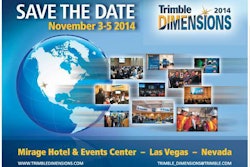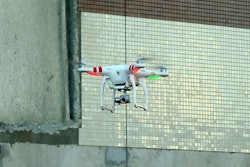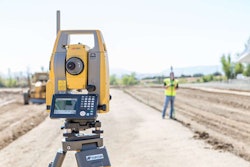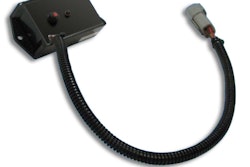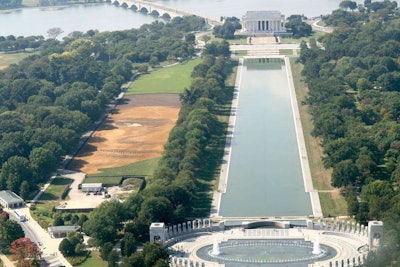 The face is drawn using rock, dirt and gravel precisely positioned using GPS data points.
The face is drawn using rock, dirt and gravel precisely positioned using GPS data points.The intrinsic power of GPS is its effectiveness in so many diverse applications. But while many tout the technology’s ability to pave a runway to millimeter specs, few would cite GPS as an artist’s tool.
Yet that is precisely what transpired on the National Mall in Washington, D.C. There, a lot of behind-the-scenes work, an arsenal of GPS equipment and a small army of volunteer workers, have helped bring the work of artist Jorge Rodríguez-Gerada to life.
The result has been nothing short of breathtaking, as a section of the Mall has been transformed from a plot of grass to a six-acre earth, sand and gravel composite portrait of a human face. Rodríguez-Gerada calls a GPS rover his “digital paintbrush,” and, given the results of the “facescape” project in our nation’s capital, it’s obvious that art and technology can make strange but very complementary bedfellows.
In the Beginning
The genesis of the facescape project dates back to late 2013 when Rodríguez-Gerada, who’d already done high-profile facescapes in several locations in Europe, was contacted by the Smithsonian Institution’s National Portrait Gallery saying they’d like to work with him on a Washington-based project.
“We sat down and discussed ideas and locations and I came back to them with what I felt could be the ideal subject matter for the work,” he said. “In light of the fact that this nation is the consummate melting pot and so many diverse ethnic groups are responsible for how we got here and what we are today, I thought a large-scale portrait depicting that reality would be perfect.”
At the outset, given that the site of choice was on the National Mall between the World War II and Lincoln Memorials, the general consensus was that the project itself would never happen. But it became obvious that the sentiment expressed in Rodríguez-Gerada’s work struck a chord with most everyone involved in the planning-phase of the project.
“Historically, it’s next to impossible to get permission to do anything on the National Mall,” said the artist. “Yet, once people found out about what we had planned, things seem to change. To be able to get an approval for something on this scale, really speaks to how even people in high positions within these institutions — the National Parks Service, the Trust for the National Mall, the Smithsonian, and so on — wanted this to happen.”
Face time
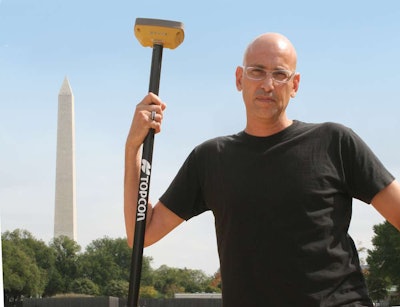 Portrait of the artist: Jorge Rodriguez-Gerada.
Portrait of the artist: Jorge Rodriguez-Gerada.The son of Cuban immigrants and a native of ethnically-diverse North Plainfield, New Jersey, Rodríguez-Gerada understands this nation’s melting-pot experience well, and wanted that richness to be evident in his work. With that in mind, he walked the National Mall for two weeks stopping people and asking permission to photograph them in his quest to create a “composite face,” one of the hundreds of millions of possible faces that reflect the diversity of this nation. From those photographs, he selected 30 final subjects and set to work pulling unique features from each and creating a composite subject. The resultant image serves as the basis for the facescape, aptly titled: “Out of Many, One,” the translation of the Latin phrase, “E Pluribus Unum,” found on the Great Seal of the United States.
The artist scanned the original etching design of the composite image and converted it to a vector file to diligently create the extremely clean lines needed for plotting out the design on the six acre scale. According to Scott Langbein, Topcon director of product marketing, the first attempt at vectoring was a classic case of “too much of a good thing. The first generation vector generated 41,000 points, which was far too dense,” he said.
“To remedy this, Jorge had a contact who redid it and brought it down to 5,000 points, but when he looked at it, he didn’t feel it had the smooth flow that he was needing; it looked chunky on the corners,” said Langbein. “So we got together at the job site trailer and took an entirely fresh approach. Using Topcon Magnet Office software, we started cleaning up the drawing and set the software to allow a maximum change of 5/100. When it regenerated the vector data, it gave us roughly 8,700 points and a much smoother design. Jorge was pleased with that result and we got ready to work.”
Breaking new ground
To create each individual element that makes up Rodríguez-Gerada’s facescape image, those 8,700 points were loaded into Topcon HiPer SR network rovers — each equipped with a Tesla controller. Survey personnel from Clark Construction used the rovers to locate and pound a stake for each point, establishing a perimeter for each feature. The stakes were then connected using twine, resulting in an outline that would later be filled in using topsoil or gravel, depending on its position within the design. According to Laura Wachs, Clark’s project superintendent, the survey and staking, like most every facet of the project, were done by the Bethesda, Md.-based company on a volunteer basis.
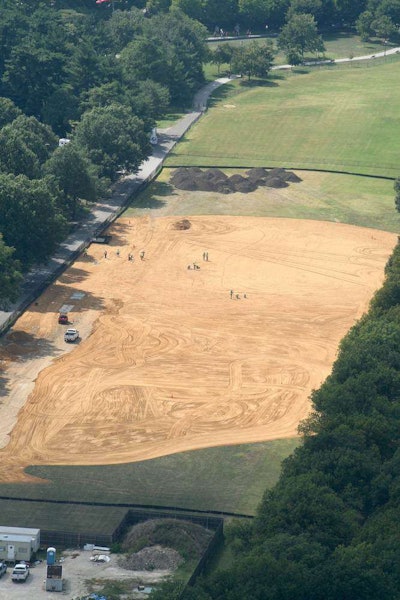 The canvas for the facescape encompassed some six acres on National Mall in Washington D.C.
The canvas for the facescape encompassed some six acres on National Mall in Washington D.C.“Clark Construction has a very solid working relationship with the Smithsonian, having done the Native American Museum and being currently involved in construction of the African American Museum,” she said. “In addition, we are working on the National Mall rehabilitation, which is being done through the National Mall Trust and the National Parks service. All three of these organizations are huge players in the facescape project, so when we were asked by them to participate, we were only too happy to do what we could.”
Clark’s construction expertise is based more in the use of robotics rather than GPS, so the facescape project was an opportunity for their survey crew to become acquainted with the network-based GPS technology which would serve to lay out each point.
“It was great to see all Clark’s surveyors around Scott Langbein and me at the start of the project,” said Oscar Cantu, Topcon software product marketing manager. “We did an overview of the equipment we’d be using and Clark’s crew grasped the technology immediately. Within 30 minutes they essentially said: ‘We’ve got it,’ and were productive from that point forward.”
Network preference
In a more traditional construction situation, data would flow to rovers through a single base station positioned on-site. However, said Langbein, the situation on the Mall was far from traditional.
“There were times when we had as many as nine rovers at work in one condensed area,” he said. “So we decided that the best approach for getting GPS/GLONASS correction data to those units was via a TopNETlive network solution. Working through one of our subscribing dealers, Caron East out of Cumberland, Maryland, tapping into the network proved to be the right move. It allowed every rover to deliver points repeatable to 1/8 of an inch, ideal for maintaining accuracies and ensuring the smoothness of Jorge’s design.”
At the end of each workday, data from every field controller — including stake reports and daily productivity rates, which helped visualize what had been done and what remained, was uploaded to the cloud. “Topcon’s Magnet software was extremely helpful in so many areas of the project,” said Rodríguez-Gerada. “It was key for work with the PDF/vector effort at the outset and it helped us track our progress through the cloud.”
The area of The Mall in which “Out of Many, One” was constructed is ringed with a fairly heavy stand of trees, which made GPS coverage spotty in a few areas. In those instances, Topcon staff brought in a DS-200 total station, employing the company’s Hybrid Positioning Technology solution. That approach allowed a combination of GNSS, optical, and automated data workflow and offset virtually all coverage challenges.
Partners in art
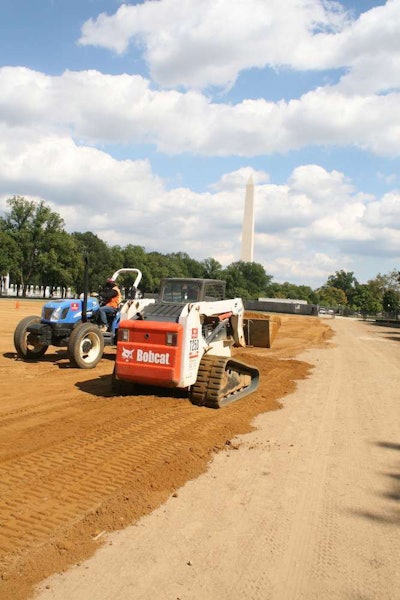 Volunteers from Clark Construction removed 100 truck loads of grass and brought in 2,000 tons of sand, 800 tons of dark topsoil and seven cubic yards of white gravel to create the facescape image.
Volunteers from Clark Construction removed 100 truck loads of grass and brought in 2,000 tons of sand, 800 tons of dark topsoil and seven cubic yards of white gravel to create the facescape image.The use of GPS technology might, at first, seem at odds with the artistic effort, which Rodríguez-Gerada has put forth, but the artist feels there is a definite common ground between the two disciplines.
“I think it’s a perfect blend,” he said. “Artists’ tools have been continually evolving, from the beginnings of the use of perspective in Renaissance art to where we are today. And through it all, it’s always been a nice blend of art, science and math. This is just another example of that and Topcon fits into it nicely.”
The relationship between Rodríguez-Gerada and Topcon dates back to 2012 and the artist’s work on a similar project in Amsterdam.
Piles of creativity
Since its official debut on October 4, Rodríguez-Gerada’s project has garnered much well-deserved praise and media coverage, both for its subject matter and the sheer scope of the work. It is, after all, the only artwork that is best viewed from the Washington Monument, from the window seat of a plane flying into or out of Reagan National Airport, or from space.
The logistics and technology brought to bear to make “Out of Many, One” a reality were impressive. However, the volumes of materials and supplies needed to bring the face to life were equally noteworthy, said Clark’s Laura Wachs.
“Just to get the six-acre site ready for work to begin, our trucks cleared and removed more than 100 truck loads of grass,” she said. “The details of the face are created from 2,000 tons of sand, 800 tons of dark, rich topsoil and seven cubic yards of white gravel. Each of the more than 8,700 stakes was pounded in by hand, and the eight-plus miles of string were hand-stapled from stake-to-stake to form the outlines needed for accurate placement of the soil. It was a labor-intensive effort, made possible through the help of an all-volunteer workforce. I’ve never seen anything else like this before, but was honored to have been a part of it.”
Here today . . .
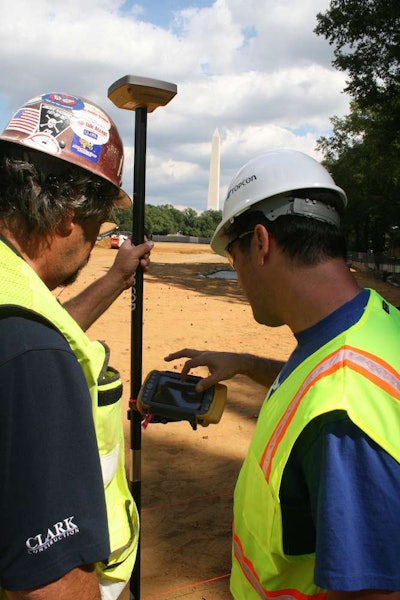 Topcon HiPer SR network rovers with Tesla controllers plotted some 8,700 points that made up the outline of the image.
Topcon HiPer SR network rovers with Tesla controllers plotted some 8,700 points that made up the outline of the image.Two of the more fascinating aspects of the project are its accessibility and the ephemeral nature of the work itself. Unlike other major works of art, which are generally cordoned off and viewable only from a safe distance, “Out of Many, One,” is open in virtually every regard. Visitors to the site are free to walk through it, much as one would walk through a public garden. Any sand or soil disturbed during viewing is raked up at the end of the day — again by volunteers — and made ready for the next day’s viewing.
Seeing a work of that size imparts an inescapable feeling of permanence, yet the massive portrait was created with an assumed lifespan of only one month. After that time, the work will be tilled into the ground and re-seeded to make way for new grass next spring. That sense of “nothing lasts forever,” and environmental purpose are common themes in many of Rodríguez-Gerada’s works.
“I try hard to incorporate elements native to the areas in which I work, and strive to leave those sites better than they were when we started. Here, this part of the National Mall, on which Clark is already conducting an extensive renovation, will have six acres of new grass next year. As to the work disappearing after such a short time, that’s true of life itself, isn’t it? I’m hoping that the implied sense of urgency will help people better process the message.”
Striking a chord
Rodríguez-Gerada adds that the real success of a piece like “Out of Many, One” is its ability to bring people together.
“Whether it’s the public lining up to see it, the volunteers who are maintaining it, or the scores of professionals from companies like Clark Construction and Topcon who helped bring my idea to life, the belief in what the work represents — this country’s growth through its embrace of diversity — apparently rang true to them.”
He added that the use of GPS in works like this has opened a lot of eyes, particularly those who have difficulty reconciling the relationship between art and technology.
“I’ve done a number of works on this scale using GPS now, and feel that I’ve really only just begun,” he said. “I’m forever thinking about art, what we can say through it, the directions in which we can take it, the difference we hope to make with it.”




